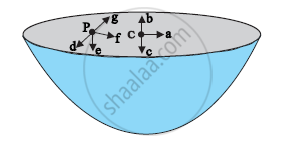Advertisements
Advertisements
प्रश्न
You can change the direction in which an object is moving by___________.
उत्तर
You can change the direction in which an object is moving by APPLYING FORCE ON IT.
APPEARS IN
संबंधित प्रश्न
The earth and the moon are attracted to each other by gravitational force. Does the earth attract the moon with a force that is greater or smaller or the same as the force with which the moon attracts the earth? Why?
The gravitational intensity at the centre of a hemispherical shell of uniform mass density has the direction indicated by the arrow (see Fig 8.12) (i) a, (ii) b, (iii) c, (iv) 0.

State two applications of universal law of gravitation.
State and explain Kepler's laws of planetary motion. Draw diagrams to illustrate these laws.
Can two particles be in equilibrium under the action of their mutual gravitational force? Can three particles be? Can one of the three particles be?
Which of the following quantities remain constant in a planetary motion (consider elliptical orbits) as seen from the sun?
Two concentric spherical shells have masses M1, M2 and radii R1, R2 (R1 < R2). What is the force exerted by this system on a particle of mass m1 if it is placed at a distance (R1+ R2)/2 from the centre?
State the law of gravitation. Why is it called universal?
What do you mean by a gravitational constant?
Solve the following problem.
Find the gravitational force between the Sun and the Earth.
Given Mass of the Sun = 1.99 × 1030 kg
Mass of the Earth = 5.98 × 1024 kg
The average distance between the Earth and the Sun = 1.5 × 1011 m.
